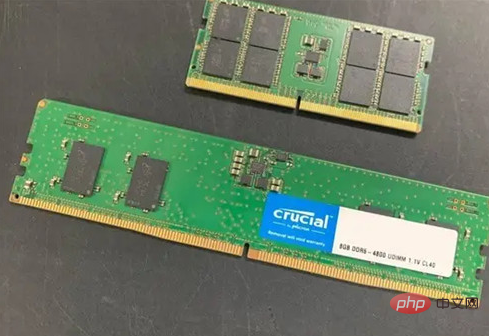Home >Common Problem >What is the use of memory stick?
What is the use of memory stick?
- WBOYWBOYWBOYWBOYWBOYWBOYWBOYWBOYWBOYWBOYWBOYWBOYWBOriginal
- 2022-07-04 17:19:4967978browse
The main function of the memory stick is to temporarily store the calculation data of the CPU and the data exchanged with external memories such as hard disks; the memory stick is responsible for the exchange of data between hardware such as hard disks, motherboards, graphics cards, and the processor. And processing, memory is a component that performs read and write operations in a bus manner.

The operating environment of this tutorial: Windows 10 system, Dell G3 computer.
What is the use of the memory stick?
The main function of the memory stick is to temporarily store the calculation data of the CPU and the data exchanged with external memories such as the hard disk. In layman's terms, it is equivalent to a bridge. .
Random access memory is an internal memory that exchanges data directly with the CPU. It can be read and written at any time, is very fast, and is often used as a temporary data storage medium for the operating system or other running programs. When RAM is working, information can be written or read from any specified address at any time. The biggest difference between it and ROM is the volatility of data, that is, the stored data will be lost once the power is turned off.
Memory is a device or component used in digital systems to store large amounts of information. It is an important part of computers and digital devices. Memory can be divided into two categories: random access memory (RAM) and read-only memory (ROM). ROM is read-only memory. In addition to fixed storage of data, tables, and firmware programs, it is also widely used in combinational logic circuits.

Expand knowledge
How to choose computer memory sticks
1. Memory brand
As for computer memory card brands, Kingston, for example, is a brand with a relatively large market share and is the first choice for most users. It is also a good choice for high-end brands such as Ji Ruida and Team Group.
2. Memory capacity
The memory capacity on the market is usually 4G, 8G, and 16G. If the installed user wants more memory, they can build it by buying multiple of the same brand and model. Generally speaking, common motherboards have 2 or 4 memory slots, and higher-end motherboards will support more memory slots.
3. Memory algebra
When selecting memory, it is also determined by referring to the motherboard memory or processor. Starting from nter100 series motherboards, you can use ddr4 memory, and the new generation of Ryzen processing The device can also use ddtR4 memory.
4. Memory frequency
Generally speaking, the memory capacity is equivalent to the diameter of the water pipe, and the memory frequency is equivalent to the valve of the water pipe. The larger the valve, the faster the water flow will be. Therefore, with the same capacity of memory, the higher the frequency, the higher the performance. The higher the frequency, the price of the memory can be said. For more related knowledge, please visit
FAQThe above is the detailed content of What is the use of memory stick?. For more information, please follow other related articles on the PHP Chinese website!
Related articles
See more- What should you pay attention to when replacing memory modules in your laptop?
- What should I do if the memory module is incompatible and the computer cannot be turned on?
- How to check the frequency of a memory stick
- What is the difference between wide and narrow memory strips?
- Are there front and back sides for installing memory modules?

